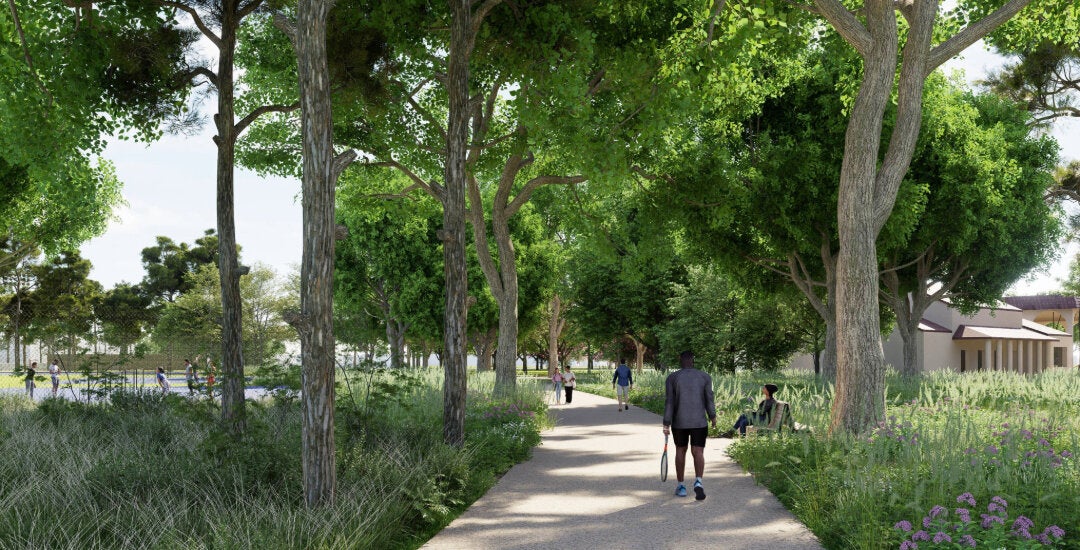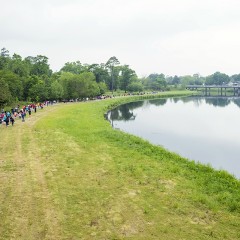According to the Kinder Institute’s “Funding Houston Parks and Greenspace” report, the city receives the second-highest amount of philanthropic support for parks in the country. However, this year it ranked No. 68 among U.S. cities in the Trust for Public Land’s ParkScore Index, which is based on acreage, access, investment, amenities and equity. Houston’s lackluster standing is thanks in part to its level of public spending on parks.
But help in the form of federal funding is on the way for a pair of parks. Burnett Bayland Park in Gulfton and MacGregor Park in southeast Houston will be upgraded in the coming years via more than $20 million in grants from the Department of the Interior’s Outdoor Recreation Legacy Partnership Program, managed by the National Park Service.
The program provides matching grants to cities for park projects in economically underserved communities and is funded through the Land and Water Conservation Fund. Burnett Bayland Park received $11.3 million in grant funding, while MacGregor Park received $10 million.
MacGregor makeover
Kinder Foundation provided a $27 million catalyst gift toward the MacGregor Park Improvement Project last December when Houston City Council approved $54 million for the project, which included $6.5 million in city funding, $4 million in tax increment reinvestment zone funding, and a $4 million federal community project grant.
The MacGregor Park project also received money from The Brown Foundation, The Fondren Foundation and Texas Children’s Hospital. The $10 million Outdoor Recreation Legacy Partnership Program grant was awarded this August.
“We remain committed to investing in projects that increase the quality of life for our community,” said Nancy Kinder, president and CEO of Kinder Foundation, in a statement. “MacGregor Park is one of Houston’s most beloved parks, and we’re thrilled to contribute to a project that further develops and preserves this important greenspace in southeast Houston.”
MacGregor Park, located less than a mile from the University of Houston, sits alongside the MacGregor and OST/South Union neighborhoods, which have a combined population of over 34,000 residents, the majority of whom are Black. The neighboring area includes several communities on each side of Brays Bayou.
The land that became MacGregor Park was donated to Houston in 1926, and according to the Houston Parks Board, the 65-acre gathering space is “showing its age.” Construction is slated to begin in 2026 and be completed by the end of 2028.
“To have the federal government recognize that this was an important project to help a disadvantaged community, like the community around MacGregor Park, was just a real shot in the arm,” said Houston Parks Board Chief Program Officer Justin Schultz. “We’re really excited that it’s moving us that much closer to our goal of $64 million.”
Schultz described a lengthy, multijurisdictional process to secure the grant.
“We submitted a request for this grant back at the beginning of 2023, and we worked very closely with our partners at the City of Houston Parks and Recreation Department,” he said. “We submitted the grant to Texas Parks and Wildlife, and then Texas Parks and Wildlife submits that up to the National Park Service. Over the course of about 16 months, that grant wound its way through the federal system.”
Schultz said that every aspect of MacGregor Park will be touched as part of the project. That will include the complete reconstruction of the Homer Ford Tennis Center and renovations to other facilities, new playgrounds and a series of new walking trails. There will also be a new amphitheater for cultural and performing arts events.
A public engagement process identified bringing nature back into the park as one of residents’ biggest priorities.
“We’re really focused on how can we continue to add additional trees, both for shade and for beauty,” Schultz said. “It’s really going to be a complete transformation. We’re really excited, because the MacGregor neighborhood deserves a park that is just as good as Memorial Park or Hermann Park.”
Strengthening Gulfton’s only park
Harris County Precinct 4 unveiled the Burnett Bayland Park Master Plan in July. In addition to renovations, 40 acres of unused land will be developed and incorporated into the park. The first phase of construction is set to begin in late 2025.
Gulfton is the hottest neighborhood in Houston, according to a 2020 heat-mapping campaign, and faces multiple challenges with nature inequity, such as a lack of tree canopy cover but few places to plant new trees.
“The positive effects of the Burnett Bayland Park revitalization project will be felt well beyond the bounds of the park,” said Reynaldo Guerra, Harris County Precinct 4’s chief infrastructure officer, in a statement.
“This is not just a park, it's community development at its core. We are building based on community needs, taking their input and infusing it into a transformative public space that addresses sustainable infrastructure, economic development, housing quality and affordability for the Greater Gulfton area.”
Precinct 4 has $39 million available for the first two phases of the Burnett Bayland plan, which includes adding more green spaces, picnic areas, ponds and sports fields.
Funding obstacles remain
While federal grants are spurring these two initiatives, Houston lags among the nation’s most populous cities in spending by its primary parks department, according to the Kinder Institute report. The Houston Parks and Recreation Department spends $32 per resident per year, far less than fellow major Texas cities Dallas ($121), San Antonio ($147) and Austin ($150).
“Our local funding for parks is challenged by the overall financial situation of our city,” Schultz said. “There are a lot of things that need to be funded with not a lot of tax money. This is where the private sector has stepped up tremendously.”
The Kinder Institute study found that Houston residents supported the city spending $100 or more per resident per year on parks, and about 70% said they would be willing to pay the city a $2 fee per month if those funds went toward improving and maintaining parks. Fifty-one percent of respondents said they would be willing to pay as much as $5 a month.
“There is no reason why a city as great as ours should receive less public funding than Austin, Dallas, San Antonio or really any other city in the country,” Schultz said. “Parks are an important public good that help our economy and our social cohesion. Parks help the health of our communities and help our environment to be more resilient to a changing climate.”



